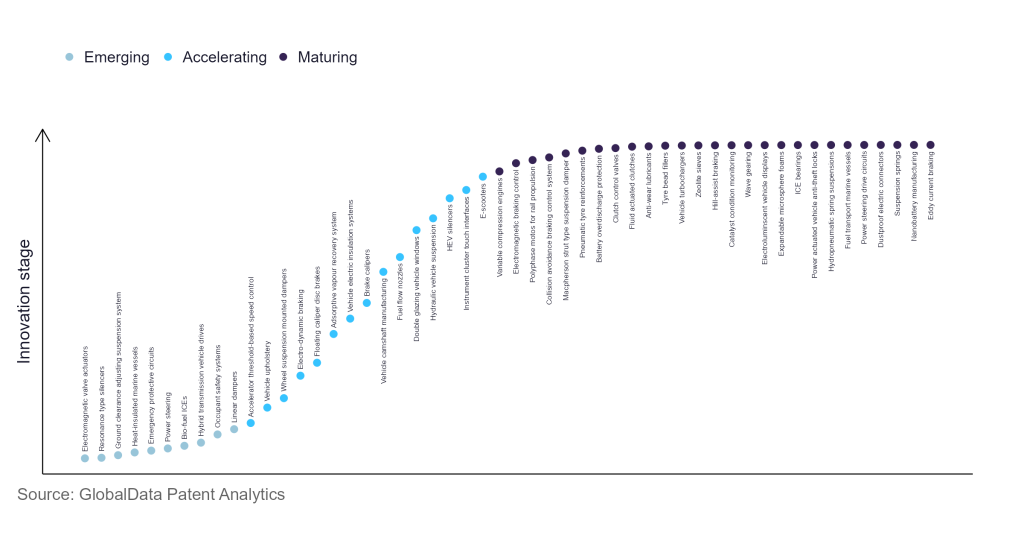The automotive industry continues to be a hotbed of innovation, with activity driven by governmental regulations, environmental safety and public health concerns and growing importance of technologies such as onboard refuelling vapour recovery, which captures fuel vapour produced during refuelling and burns it during regular operation. Onboard refuelling vapour recovery contributes to 95% reduction in hydrocarbon emissions. In the last three years alone, there have been over 1.2 million patents filed and granted in the automotive industry, according to GlobalData’s report on Innovation in Automotive: Adsorptive vapour recovery system. Buy the report here.
However, not all innovations are equal and nor do they follow a constant upward trend. Instead, their evolution takes the form of an S-shaped curve that reflects their typical lifecycle from early emergence to accelerating adoption, before finally stabilising and reaching maturity.
Identifying where a particular innovation is on this journey, especially those that are in the emerging and accelerating stages, is essential for understanding their current level of adoption and the likely future trajectory and impact they will have.
290+ innovations will shape the automotive industry
According to GlobalData’s Technology Foresights, which plots the S-curve for the automotive industry using innovation intensity models built on over 619,000 patents, there are 290+ innovation areas that will shape the future of the industry.
Within the emerging innovation stage, eccentric crankshaft gears, retarder brake systems, and closed-circuit liquid cooling are disruptive technologies that are in the early stages of application and should be tracked closely. Bio-fuel ICEs, electromagnetic valve actuators, and road friction estimation are some of the accelerating innovation areas, where adoption has been steadily increasing. Among maturing innovation areas are tyre bead fillers and vehicle turbochargers, which are now well established in the industry.
Innovation S-curve for the automotive industry

Adsorptive vapour recovery system is a key innovation area in automotive
Vapour recovery systems are devices that prevent fuel vapours from escaping into the atmosphere by collecting the vapours of gasoline and other fuels. The vapours are transformed into liquid fuel and once more pumped into the tank. The technique is mostly used with large storage tanks where the gas vapour emission is significant.
GlobalData’s analysis also uncovers the companies at the forefront of each innovation area and assesses the potential reach and impact of their patenting activity across different applications and geographies. According to GlobalData, there are 30+ companies, spanning technology vendors, established automotive companies, and up-and-coming start-ups engaged in the development and application of adsorptive vapour recovery system.
Key players in adsorptive vapour recovery system – a disruptive innovation in the automotive industry
‘Application diversity’ measures the number of different applications identified for each relevant patent and broadly splits companies into either ‘niche’ or ‘diversified’ innovators.
‘Geographic reach’ refers to the number of different countries each relevant patent is registered in and reflects the breadth of geographic application intended, ranging from ‘global’ to ‘local’.
Patent volumes related to adsorptive vapour recovery system
Source: GlobalData Patent Analytics
Aisan Industry is one of the top players in adsorptive vapour recovery system segment. Aisan Industry has filed 143 patents for technology advancement of adsorptive vapour recovery system. Another prominent company, Geely, filed a patent for an onboard refuelling vapour recovery system, which consists of a carbon canister and a backup carbon canister filled with activated carbon. Other companies in adsorptive vapour recovery systems are Mahle, Hyundai and Futaba Industrial.
To further understand the key themes and technologies disrupting the automotive industry, access GlobalData’s latest thematic research report on Automotive.
Data Insights
From

The gold standard of business intelligence.
Blending expert knowledge with cutting-edge technology, GlobalData’s unrivalled proprietary data will enable you to decode what’s happening in your market. You can make better informed decisions and gain a future-proof advantage over your competitors.



